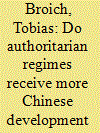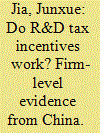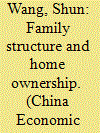|
|
|
Sort Order |
|
|
|
Items / Page
|
|
|
|
|
|
|
| Srl | Item |
| 1 |
ID:
159078


|
|
|
|
|
| Summary/Abstract |
Exploiting the variations in household income and consumption structure, this paper corrects the measurement errors of consumption expenditure reported by households in different income classes. By using the Urban Household Survey (UHS) data, empirical results demonstrate that consumption inequality in urban China increased by 67% during the sample period and it was much larger than 36%, which was obtained directly from the reported raw data. Precisely, from 1993 to 2007, the consumption inequality experienced a rapid increase, but began to decrease after 2008. Since 2002, underreporting of consumption expenditure was more evident for households with higher income. Furthermore, the consumption inequality in central and western regions, and that of the households with higher education levels were more serious and constituted important driving forces for the increase of consumption inequality.
|
|
|
|
|
|
|
|
|
|
|
|
|
|
|
|
| 2 |
ID:
159077


|
|
|
|
|
| Summary/Abstract |
This study is part of an emerging literature that aims to shed light on China's development finance activities in Africa using quantitative estimation techniques. This paper empirically investigates whether African authoritarian regimes receive more Chinese development finance than democratic ones. I use four different measures of democracy/autocracy which allows me to check whether my results depend on the specific indicator chosen. The OLS results suggest that Chinese development finance does not systematically flow to more authoritarian countries, controlling for strategic, economic, political, institutional and geographic confounding factors. The results are not driven by the specific democracy indicator used in the analysis. The findings remain virtually unchanged if I reduce the sample to Sub-Saharan Africa only. Furthermore, the results stand up to several robustness checks, including FE, RE and instrumental variable estimation.
|
|
|
|
|
|
|
|
|
|
|
|
|
|
|
|
| 3 |
ID:
159069


|
|
|
|
|
| Summary/Abstract |
Tax incentives have been used worldwide to encourage firm R&D, but there is little evidence on their effectiveness as a policy tool in developing countries. We use a panel dataset of Chinese listed companies covering 2007 to 2013 to assess the effects of tax incentives on firm R&D expenditures and analyze how institutional conditions shape these effects. Our results show that tax incentives motivate R&D expenditures for our sample firms. A 10% reduction in R&D user costs leads firms to increase R&D expenditures by 3.97% in the short run. We also find considerable effect heterogeneity: Tax incentives significantly stimulate R&D in private firms but have little influence on state-owned enterprises' R&D expenditures. Moreover, the effects of tax incentives are more pronounced for private firms without political connections. Hence, reducing political intervention complements tax incentives' capacity to foster firm R&D in developing countries.
|
|
|
|
|
|
|
|
|
|
|
|
|
|
|
|
| 4 |
ID:
159076


|
|
|
|
|
| Summary/Abstract |
This paper studies how individuals, particularly low-income individuals, have financed housing purchases since the housing market was privatized in urban China in the 1990s. To the surprise of many policy makers and economists, more than 80% of the households in urban China owned private housing by the end of 2010. In contrast to most developed countries, we find that male siblings are important borrowing resources to purchase housing. Conditional on the number of siblings, having more brothers instead of sisters increases the probability of owning housing among male individuals born during the baby boom (1949–1978) in urban China. However, there is no such brother effect for females. The brother effect is stronger for males with low income or low levels of education and is also stronger when brothers are wealthier. Our results are robust to different model specifications. Our results suggest that females are likely to be excluded from family-based informal financial market for housing purchase among baby boom generations in China.
|
|
|
|
|
|
|
|
|
|
|
|
|
|
|
|
| 5 |
ID:
159074


|
|
|
|
|
| Summary/Abstract |
The compulsory school merger program in rural regions of China imposed higher education costs on rural residents, decreased their consumption and reduced their welfare. In this study, we employ household-level data and the difference-in-differences method to analyze the policy effect on residents' consumption and education costs. Our results show that the compulsory school merger program had a negative effect on the consumption of rural residents and inflicted multiple education costs on them. We also find that the increase in the distance between school and home is an important explanation for the effect of this policy on rural residents' education costs.
|
|
|
|
|
|
|
|
|
|
|
|
|
|
|
|
| 6 |
ID:
159084


|
|
|
|
|
| Summary/Abstract |
This paper analyzes the substitution and trade-off effects of homeownership and housing price on social security expenditure. We construct a theoretical model to investigate the optimal choice for individual and government in social security system with estate transaction. The model predicts that the government is more likely to decrease (increase) social security spending under a higher home rate when house price rises (falls). We test 35 metropolises panel data which spans the year of 1998–2012 under a two-way fixed effects framework. Our empirical analysis supports the theoretical prediction. The estimation results show that at the current home rate 82%, 1% increase in housing price will lead to 1.15 Yuan reduction in social security spending per capita.
|
|
|
|
|
|
|
|
|
|
|
|
|
|
|
|
| 7 |
ID:
159080


|
|
|
|
|
| Summary/Abstract |
As the population bonus disappeared, the wage rate has increased significantly since the early 2000s in China. Increasing wages have significantly affected export-oriented industries as well as agriculture. Mechanization is another factor affecting China's agriculture. This study shows the increasing wage and the mechanization have a negative impact on land area devoted to labor-intensive crops but a positive impact on land area devoted to labor-extensive crops. Based on nationally representative data, the empirical results conform well to the theoretical predictions.
|
|
|
|
|
|
|
|
|
|
|
|
|
|
|
|
| 8 |
ID:
159082


|
|
|
| 9 |
ID:
159070


|
|
|
|
|
| Summary/Abstract |
China provides a unique experience of massive internal (within-country) migration but with high segregation of jobs between migrants and natives. Thus, migration has a complementary external effect on native wages: the elasticities of complementarity of migrants are about 31.7%, 20.3%, and 19.9% for native workers with a college, high school and less than high school education, respectively. After the wage is deflated by the housing price, the elasticities decline to 11%, 8.2% and −4.4% for the respective education groups, which provides the lower-bound analysis results. In addition, migration has widened wage dispersion, as well as increasing the education premium and residual inequality. The elasticity of substitution in jobs between migrants and natives is very low due to the hukou restriction, and increasing proportions of migrants in any given labor force widen the migrant/native wage gap. Job segregation is an important factor that explains particular labor market findings in China.
|
|
|
|
|
|
|
|
|
|
|
|
|
|
|
|
| 10 |
ID:
159081


|
|
|
|
|
| Summary/Abstract |
This paper constructs a monthly Chinese business condition index (CBCI) by using a mixed-frequency state-space model to incorporate economic indicators from different frequencies. The modeling strategy is necessary to account for the Chinese labor market conditions. When choosing the components, we pay special attention to the reliability of Chinese data by avoiding the variables that are likely subject to government manipulation or mismeasurement. Comparisons of the CBCI and official indicators show discrepancies before 2009 and consistency afterwards, supporting the argument that Chinese official data improve markedly after 2008. An out-of-sample prediction justifies the usefulness of the CBCI in forecasting the private sector's perception of the business conditions.
|
|
|
|
|
|
|
|
|
|
|
|
|
|
|
|
| 11 |
ID:
159073


|
|
|
|
|
| Summary/Abstract |
This paper uses 13,766 firm-year observations between 2003 and 2013 from China to investigate the effects of monetary policy on corporate investment and the mitigating effects of cash holding. We find that tightening monetary policy reduces corporate investment while cash holdings mitigate such adverse effects. The cash mitigating role is especially significant for financially constrained firms, non-state-owned enterprises (non-SOEs) and those firms located in a less developed financial market. Cash holding also improves investment efficiency when monetary policy is tightening and tightening monetary policy enhances the ‘cash-cash flow’ sensitivity. Our empirical evidence calls for a critical evaluation on the monetary policies implemented in China which are less effective for state-owned enterprises. It also calls for a necessity for local government to further develop regional financial markets to protect vulnerable businesses, such as non-SOEs and financially constrained firms, from external shocks in order to maintain their sustainable growth and competitive advantages.
|
|
|
|
|
|
|
|
|
|
|
|
|
|
|
|
| 12 |
ID:
159075


|
|
|
|
|
| Summary/Abstract |
This paper contributes to the systematic understanding of Chinese investment abroad, and particularly the role of state-owned enterprise (SOE) investors, in two ways. Firstly, we identify major problems in the literature stemming from wide-spread data deficiencies in data. Specifically, the reliability of previous research results has been limited by data sets that do not identify the final destination for Chinese investment, nor suitably differentiate between different ownership types. By augmenting the project-level data from the China Global Investment Tracker with detailed ownership information for each firm, this study reveals that large-scale investment in natural resource investment, which surged after 2008, is dominated by state-owned enterprises controlled by China's central government. But it also reveals a newer wave of non-resource investment after 2009 in which non-state enterprise plays the leading role.
|
|
|
|
|
|
|
|
|
|
|
|
|
|
|
|
| 13 |
ID:
159068


|
|
|
|
|
| Summary/Abstract |
Based on a random sample from 1 percent population survey data of 2005, this paper studies the impacts of Tangshan Earthquake on the educational attainment and subsequent labor market outcomes of affected cohorts using the methodology of difference-in-differences model and the local average treatment effect interpretation of instrumental variables technique. We find that the schooling years of the cohorts potentially affected by Tangshan Earthquake is 14%–21% of a year of schooling lower than the non-earthquake cohorts, which can be considered as the shortterm educational cost of Tangshan Earthquake. The rate of returns to years of schooling for the earthquake cohorts is 20.93%–27.85%. The earthquake leads 3.51%–4.77% loss of average income through the reduction of schooling years. A loss of 0.30%–0.41% of GDP in 2005 can be attributed to the lower educational attainment of the earthquake cohorts, which can be considered as the long-term educational cost of Tangshan Earthquake.
|
|
|
|
|
|
|
|
|
|
|
|
|
|
|
|
| 14 |
ID:
159066


|
|
|
|
|
| Summary/Abstract |
This paper investigates possible impacts of religious diversity on regional development in China. We developed the religious fragmentation and polarization indices as measurements for the religious diversity by using the religious site data from the 2004 economic Census data in China. The results from the panel data regressions within national coverage suggest that the religious diversity has positive and significant impacts on regional development in general. The results from the panel data regressions within regional coverage also suggest that religious fragmentation has a positive and significant association with the economic development in the eastern region of China while religious polarization has a positive and significant association with the economic development in the central and western regions of China.
|
|
|
|
|
|
|
|
|
|
|
|
|
|
|
|
| 15 |
ID:
159067


|
|
|
|
|
| Summary/Abstract |
We find that the increased supply of college graduates resulting from college enrollment expansion in China increases college premiums for older cohorts and decreases college premiums for younger cohorts. This finding is inconsistent with the canonical model that assumes substitution among workers of different ages. We subsequently build a simple model that considers complementarities among workers of different ages and different skill levels. Our model predicts that the college premium of senior workers increases with the supply of young college graduates when skill is a scarce resource. The model's predictions are supported by empirical tests.
|
|
|
|
|
|
|
|
|
|
|
|
|
|
|
|
| 16 |
ID:
159083


|
|
|
|
|
| Summary/Abstract |
This paper analyses how economic integration and the international division of labour have evolved among the ASEAN + 3 countries in the last 20 years. The paper proposes an indicator of the level of technological sophistication based on revealed comparative advantages and uses it to investigate the relation between technological advance, factor endowments and supply chain trade. It is shown that supply chain-trade does not facilitate technological transfer. On the contrary: FDI appears to have significant and negative spill-over effects on technological change. Positive spill-overs from FDI materialize only when host countries have sufficiently high levels of education.
|
|
|
|
|
|
|
|
|
|
|
|
|
|
|
|
| 17 |
ID:
159071


|
|
|
|
|
| Summary/Abstract |
We examine whether a firm's import content share differentially affects the degree of tariff and exchange rate pass-through into its export prices. Our pricing-to-market model suggests that a firm's import content share negatively affects the degree of exchange rate pass-through but does not affect the degree of tariff pass-through. Using firm-level data for Chinese exporting firms during the period 2000–2006, we find evidence of an almost complete exchange rate pass-through. As expected, when we distinguish firms by their trade regime, processing-trade firms, especially pure-assembly firms which tend to have higher import-content share, have a lower exchange rate pass-through than ordinary trade firms. We find no evidence that the tariff pass-through differs across the various trade regimes.
|
|
|
|
|
|
|
|
|
|
|
|
|
|
|
|
| 18 |
ID:
159072


|
|
|
|
|
| Summary/Abstract |
This paper, based on data from China after its membership into the World Trade Organization (WTO), shows the co-existence of a fluctuating skill premium and rises in wages for both skilled and unskilled labor. Our research provides one specific factor, the tariff reduction biased toward unskilled labor-intensive sectors, to explain and quantify the magnitudes of skill premium dynamics using the mandated-wage approach. The empirical evidence indicates that sector-biased tariff reductions have widened wage inequality in China through their effect on product prices. World price competition, on the other hand, has contributed to declining wage inequality via product prices, which is consistent with the endowment-based expectations of China's integration into the more skilled-labor abundant world.
|
|
|
|
|
|
|
|
|
|
|
|
|
|
|
|
| 19 |
ID:
159079


|
|
|
|
|
| Summary/Abstract |
Since Chinese government initiated economic reform in the late 1970s, entrepreneurship and private sectors have emerged gradually and played an increasingly important role in promoting economic growth. However, entrepreneurship is distributed unevenly in China. Using micro data from 2008 economic census and 2005 population census, this paper explains spatial clusters of entrepreneurship for both manufacturing and services. For both sectors, entrepreneurship (measured by new private firms) tends to emerge in places with more relevant upstream and downstream firms. Moreover, Chinitz's (1961) theories are also supported for manufacturing: small upstream and downstream firms seem to be more important for manufacturing entrepreneurship. For both sectors, entrepreneurship is positively related to city size, the share of young adults and the elderly population, and foreign direct investment. More migrants are also found to promote service entrepreneurship. Our paper is the first to consider both manufacturing and service entrepreneurship in China and should be of interest to both local and national policymakers who plan to encourage entrepreneurship.
|
|
|
|
|
|
|
|
|
|
|
|
|
|
|
|
|
|
|
|
|